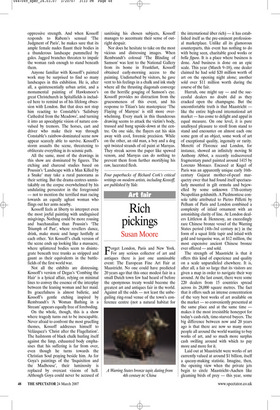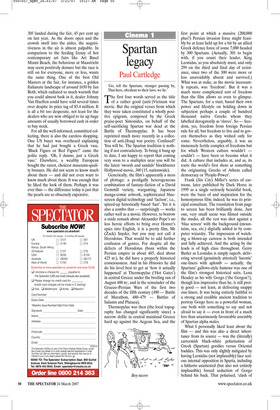Rich pickings
Susan Moore
Forget London, Paris and New York. For any serious collector of art and antiques there is just one unmissable event: The European Fine Art Fair at Maastricht. No one could have predicted 20 years ago that this once modest fair in a small Dutch town few had heard of before the eponymous treaty would become the greatest art and antiques fair in the world. Against all the odds — not least the unbeguiling ring-road venue of the town’s conference centre (not a natural habitat for the international fiber rich) — it has established itself as the pre-eminent professional marketplace. Unlike all its glamorous counterparts, this event has nothing to do with being seen, charitable good works or bella figura. It is a place where business is done. And business is done on an epic scale. This year (March 9–18), one dealer claimed he had sold $20 million worth of art on the opening night alone; another sold over $11 million worth during the course of the fair.
Hurrah, one might say — and the successful dealers no doubt did as they cracked open the champagne. But the uncomfortable truth is that Maastricht like the entire high-end international art market — has come to delight and appal in equal measure. On one level, it is pure unalloyed pleasure to stroll from stand to stand and encounter on almost each one some gem of an object, some work of art of exceptional quality, ingenuity or rarity. Moretti of Florence and London, for instance, showed an infinitely moving St Anthony Abbot, a recently rediscovered fragmentary panel painted around 1415 by Lorenzo Monaco. Encased at Kugel of Paris was an apparently unique early 16thcentury Gujarat mother-of-pearl marquetry ewer that had found itself spectacularly mounted in gilt ormolu and bejewelled by some unknown 17th-century Neapolitan goldsmith. A Piedmontese console table attributed to Pietro Piffetti by Pelham of Paris and London combined a complexity of inlaid ornament with an astonishing clarity of line. At London dealers Littleton & Hennessy, an exceedingly rare Chinese bronze vessel of the Warring States period (4th–3rd century BC) in the form of a squat little tapir and inlaid with gold and turquoise was, at $12 million, the most expensive ancient Chinese bronze ever offered — and sold.
The strength of Maastricht is that it offers this kind of experience and quality on a scale unparalleled elsewhere. It is, after all, a fair so large that its visitors are given a map in order to navigate their way around. At the last count, there were some 220 dealers from 15 countries spread across its 28,000 square metres. The fact that it offers such an intense concentration of the very best works of art available on the market — so conveniently presented at the same place and at the same time makes it the most irresistible honeypot for today’s cash-rich, time-starved buyers. The big difference between now and 20 years ago is that there are now so many more people all around the world wanting to buy works of art, and so much more surplus cash swilling around with which to pay more and more for it.
Laid out at Maastricht were works of art currently valued at around $1 billion, itself a queasy-making statistic. Imagine, then, the opening view when the private jets begin to circle Maastricht–Aachen like gleaming birds of prey — this year, some 305 landed during the fair, 45 per cent up on last year. As the doors open and the crowds swell into the aisles, the acquisitiveness in the air is almost palpable. In comparison to the feeding frenzy of hot contemporary art fairs like Art Basel Miami Beach, the behaviour at Maastricht may seem positively demure but the race is still on for everyone, more or less, wants the same thing. One of the best Old Masters at the fair, for instance, a golden Italianate landscape of around 1650 by Jan Both, which radiated so much warmth that you could almost bask in it, dealer Johnny Van Haeften could have sold several times over despite its price tag of $5.4 million. It is all a bit too desperate, not least for the dealers who are now obliged to tie up huge amounts of usually borrowed cash in order to buy stock.
For all the well-informed, committed collecting, there is also the careless shopping. One US buyer was overheard explaining that he had just bought a Greek vase. ‘Black Figure or Red Figure?’ came the polite reply. ‘Oh, I dunno, just a Greek vase.’ Elsewhere, a wealthy European bought the rarest, choicest museums-quality bronzes. He did not seem to know much about them — and did not even want to know much about them. It was enough that he liked the look of them. Perhaps it was ever thus — the difference today is just that the pearls are so obscenely expensive.



















































































 Previous page
Previous page